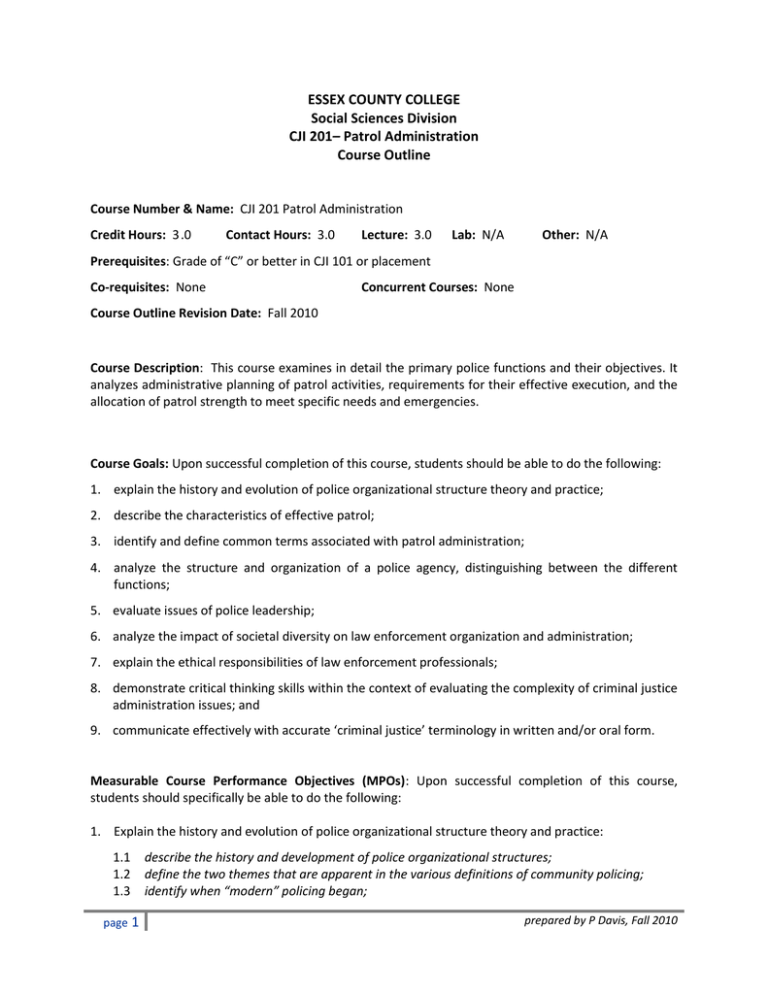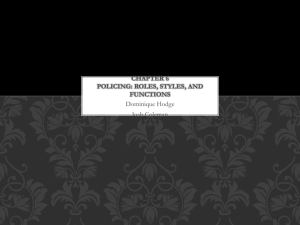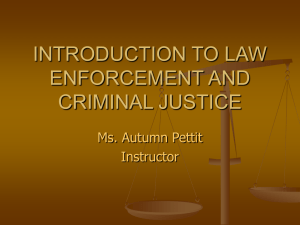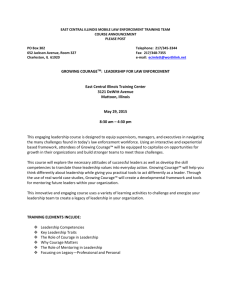Student Learning Outcomes (SLO)
advertisement

ESSEX COUNTY COLLEGE Social Sciences Division CJI 201– Patrol Administration Course Outline Course Number & Name: CJI 201 Patrol Administration Credit Hours: 3 .0 Contact Hours: 3.0 Lecture: 3.0 Lab: N/A Other: N/A Prerequisites: Grade of “C” or better in CJI 101 or placement Co-requisites: None Concurrent Courses: None Course Outline Revision Date: Fall 2010 Course Description: This course examines in detail the primary police functions and their objectives. It analyzes administrative planning of patrol activities, requirements for their effective execution, and the allocation of patrol strength to meet specific needs and emergencies. Course Goals: Upon successful completion of this course, students should be able to do the following: 1. explain the history and evolution of police organizational structure theory and practice; 2. describe the characteristics of effective patrol; 3. identify and define common terms associated with patrol administration; 4. analyze the structure and organization of a police agency, distinguishing between the different functions; 5. evaluate issues of police leadership; 6. analyze the impact of societal diversity on law enforcement organization and administration; 7. explain the ethical responsibilities of law enforcement professionals; 8. demonstrate critical thinking skills within the context of evaluating the complexity of criminal justice administration issues; and 9. communicate effectively with accurate ‘criminal justice’ terminology in written and/or oral form. Measurable Course Performance Objectives (MPOs): Upon successful completion of this course, students should specifically be able to do the following: 1. Explain the history and evolution of police organizational structure theory and practice: 1.1 1.2 1.3 page 1 describe the history and development of police organizational structures; define the two themes that are apparent in the various definitions of community policing; identify when “modern” policing began; prepared by P Davis, Fall 2010 Measurable Course Performance Objectives (MPOs) (continued): 1.4 1.5 1.6 1.7 1.8 1.9 1.10 1.11 list and describe the principles Sir Robert Peel emphasized; list and describe the three eras of policing; describe the police relationship with the community during each era; describe what the professional model of policing emphasizes; describe how law enforcement agencies have traditionally been organized; describe the police organizational design; list and describe some of the common types of crime prevention programs; and list the four essential dimensions of community policing 2. Describe the characteristics of effective patrol: 2.1 2.2 2.3 2.4 2.5 2.6 2.7 2.8 2.9 2.10 2.11 2.12 2.13 2.14 2.15 2.16 describe the appropriate steps to prepare for patrol; describe basic police field procedures; identify what dilemmas face law enforcement; outline the three levels of law enforcement; list the four basic responsibilities of the police; identify the differences between the police academy and field training as learning tools for recruits; list the three primary purposes of police patrol; explain the use of force continuum; identify when officers exercise discretion; describe how discretion fits into the community policing philosophy; list the goals of the Commission on Accreditation for Law Enforcement Agencies; describe three styles of law enforcement as described by James Q Wilson; explain why differential response strategies enable police departments to respond more efficiently to 911 calls; describe proper crime scene procedures; discuss the importance of forensic evidence; and describe the procedures involved in a constitutionally sound criminal investigation indicate some investigation strategies that are considered aggressive; describe how forensic experts use DNA fingerprinting to solve crimes; outline the four major sources that may provide probable cause; list the four elements that must be present for an arrest to take place; list the four categories of items that can be seized by use of a search warrant; explain when searches can be made without a warrant; recite the Miranda warning; indicate situations in which a Miranda warning is unnecessary; and list the three basic types of police identification 3. Identify and define common terms associated with patrol administration: 3.1 3.2 3.3 3.4 page 2 identify the concepts of the police organization and describe the police organizational design; define COMPSTAT and identify the core principles of COMPSTAT as it is practiced by the New York City police; describe the components of traditional programs for youths that have promoted positive police-community relations and enhanced crime prevention efforts; describe some crime analysis techniques; and prepared by P Davis, Fall 2010 Measurable Course Performance Objectives (MPOs) (continued): 3.5 define the four primary responsibilities of the Department of Homeland Security 4. Analyze the structure and organization of a police agency, distinguishing between the different functions: 4.1 4.2 4.3 4.4 4.5 4.6 4.7 4.8 4.9 4.10 4.11 4.12 4.13 interpret, recognize and analyze important legal issues faced by criminal justice managers; describe current administration problems and issues; recognize appropriate police management techniques; describe how efficiency and effectiveness differ, and identify which community policing emphasizes; examine the planning and decision making process employed by police organizations; explain the principle of hierarchy as it relates to organizational design; describe the concept of span management; distinguish between vertical and horizontal differentiation; discuss the differences between tall organizational structures and flat organizational structures; list and describe four types of structural design; describe the leadership function within a law enforcement organization; describe the recruitment function within a law enforcement organization; and describe the career advancement function within a law enforcement organization 5. Evaluate issues of police leadership: 5.1 5.2 describe the characteristics of a mission statement; explain the differences between management practices in public organizations compared to private entities; 5.3 describe what characteristics of the police culture may lead to a code of silence; 5.4 explain the basic organizational structure of criminal justice entities and the management constraints imposed by these structures; 5.5 describe the skills of effective management; 5.6 relate management concepts, in general, to police organizations and administration specifically; 5.7 describe the role of politics and political affiliation in managing criminal entities; 5.8 identify what dilemmas face law enforcement leadership; 5.9 distinguish between the concepts of management and leadership; and 5.10 recognize appropriate police management techniques 6. Analyze the impact of societal diversity on law enforcement organization and administration: 6.1 6.2 6.3 6.4 6.5 6.6 6.7 6.8 page 3 describe how the makeup of the police force has changed in recent years; identify what individual characteristics are important in the communication process; identify the two critical barriers to communication in a diverse society; describe why police officers may have more barriers to communication than other professionals and what these barriers consist of; identify what dilemma law enforcement officers face when interacting with immigrants; describe what is needed to avoid discrimination; identify the difference between prejudice and discrimination; and describe why communicating effectively with all law enforcement personnel and the public is important prepared by P Davis, Fall 2010 Measurable Course Performance Objectives (MPOs) (continued): 7. Explain the ethical responsibilities of law enforcement professionals: 7.1 describe and evaluate the importance of ethical issues and principles in managing criminal justice organizations; 7.2 compare and contrast examples of contemporary programs dealing with ethical issues; 7.3 discuss how the patronage system affected policing; 7.4 indicate the results of the Wickersham commission; 7.5 explain the term “abuse of discretion;” 7.6 identify the three traditional forms of police corruption; 7.7 explain what an ethical dilemma is and name four categories of ethical dilemmas typically facing a police officer; 7.8 identify what ethics involves; 7.9 identify the three ethics checks; and 7.10 describe strategies designed to address a code of silence 8. Demonstrate critical thinking skills within the context of evaluating the complexity of criminal justice management issues: 8.1 8.2 8.3 8.4 explain, evaluate and apply important theories and skills regarding patrol issues; appraise current literature, materials and developments regarding patrol within criminal justice agencies; explain the significance of the decision in each of the following US Supreme cases: Mapp v Ohio (1966), Gideon v Wainwright (1963), Escobito v Illinios (1964), and Miranda v Arizona (1966) and apply each to a hypothetical situation; and use critical thinking and problem solving; focusing on the criminal justice management and analyzing information from multiple sources, including the print and video media 9. Communicate effectively with accurate ‘criminal justice’ terminology in written and/or oral form: 9.1 9.2 utilize effective and persuasive communication skills in written and/or oral form; and use accurate ‘criminal justice’ terminology in writings and oral presentations Methods of Instruction: Instruction will consist of, but not be limited to, a combination of lectures, class discussions, multi-media presentations, group projects, the assignment of textbook readings and other resource material, case studies, demonstrations, and completion of various assessment instruments (a documented research paper, and both in-class and take-home tests and exams). Specific choice of instructional methods is left to the discretion of the instructor. Outcomes Assessment: Quiz and exam questions (if applicable) are blueprinted to course objectives. Checklist rubrics are used to evaluate non-test type assessment instruments, such as case studies, presentations, logs, journals, and papers, for the presence of course objectives. Data collected will be analyzed to provide direction for the improvement of instruction, viability of class assignments, relevancy of assigned literature, and evaluation of instructional time spent on specific topics. page 4 prepared by P Davis, Fall 2010 Course Requirements: All students are required to: 1. Maintain regular attendance. 2. Actively participate in class discussions and workshops. 3. Read the recommended textbook and any other assigned resource materials. 4. Complete all assigned homework on time. 5. Complete all written assignments, including a research paper based on multiple source research gleaned from appropriate library sources and previously published internet sources. 6. Complete an in-class midterm and final examination. 7. Take all quizzes and exams when scheduled. 8. Follow any specific class requirements mandated by the instructor. Methods of Evaluation: Final course grades will be computed as follows: Grading Components Attendance/Class Participation % of final course grade 5 – 15% Attendance points will be computed based on the ratio of the number of days attending the course during a regular semester (i.e., 28 contact days). A similar procedure will be used to determine participation points. Logs/Journals 10 – 15% Logs/Journals are written exercises designed to heighten student’s awareness of various events related to criminal justice that is experienced, observed, read, or viewed on television. Student must relate experiences to chapters either discussed/not discussed throughout the semester . Reaction Papers 15 – 20% Reaction papers are 3 – 5 page written exercises in which students read outside sources or statements supplied by the professor an discuss their “intellectual and emotional” reaction to the issue or author’s point of view, yet use critical thinking guidelines to take a position and support that position using scholarly literature, interviews and polling. Theme Papers 20 – 25% Theme papers are 3 – 5 page written exercises in which students discuss how taking the course has been personally meaningful, beneficial, and relevant to their future professional aspirations. References can be cited using scholarly journals, criminological, legal and law enforcement sources, or internet sites. page 5 prepared by P Davis, Fall 2010 Methods of Evaluation (continued): Grading Components Literature Reviews/Research Papers % of final course grade 10 – 20% Literature reviews/research papers are written exercise in which students must investigate a particular topic either in the textbook or assigned by the instructor that is related to the course objectives and conduct a review of the criminological literature, case law, management guidelines or statues. Based on the literature review, students are required to develop a thesis/theme and draw conclusions on the topic researched. Introspective Theme Paper/Case Study Analysis 30 – 40% The introspective theme paper/case study analysis is a 7 – 10 page written exercise in which students integrate and synthesize concepts to perform an in-depth analysis and demonstrate relevance of various theories to management issues. The students must analyze, synthesize, integrate, and demonstrate relevance of concepts to course objectives. Written/Oral Presentation Interview of Law Enforcement Agency or Professional in the Field 15 – 25% The written/oral presentation of the interview of law enforcement agency representative or professional requires the student to gather information and to determine its relevance to concepts and theories presented in class which are related to course objectives. Oral Presentations 15 – 20% Oral presentations are based on a topic either discussed/not discussed during the semester that is relevant to the study of criminal justice or police management and related to course objectives. The instructor may require a written outline to augment the oral presentation. Quizzes 10 – 15% Quizzes will provide evidence of the extent to which students have met course objectives. Exams, including Midterm and Final Exams (number of exams and dates specified by the instructor) 20 – 30% Exams will provide evidence of the extent to which students have mastered and synthesized course material and have met course objectives. NOTE: The instructor will determine (as appropriate) the specific components for the course and provide specific weights which lie in the above given ranges at the beginning of the semester. page 6 prepared by P Davis, Fall 2010 Academic Integrity: Dishonesty disrupts the search for truth that is inherent in the learning process and so devalues the purpose and the mission of the College. Academic dishonesty includes, but is not limited to, the following: plagiarism – the failure to acknowledge another writer’s words or ideas or to give proper credit to sources of information; cheating – knowingly obtaining or giving unauthorized information on any test/exam or any other academic assignment; interference – any interruption of the academic process that prevents others from the proper engagement in learning or teaching; and fraud – any act or instance of willful deceit or trickery. Violations of academic integrity will be dealt with by imposing appropriate sanctions. Sanctions for acts of academic dishonesty could include the resubmission of an assignment, failure of the test/exam, failure in the course, probation, suspension from the College, and even expulsion from the College. Student Code of Conduct: All students are expected to conduct themselves as responsible and considerate adults who respect the rights of others. Disruptive behavior will not be tolerated. All students are also expected to attend and be on time for all class meetings. No cell phones or similar electronic devices are permitted in class. Please refer to the Essex County College student handbook, Lifeline, for more specific information about the College’s Code of Conduct and attendance requirements. page 7 prepared by P Davis, Fall 2010 Course Content Outline: based on the text by Birzer, Michael and Cliff Roberson (2008). Police Field Operations: Theory Meets Practice. Upper Saddle River, NJ: Prentice Hall. Recommended Supplemental Resources: Swanson, Charles, Leonard Territo and Robert Taylor (2008). Police Administration: Structures, Process and Behavior (8th edition or current edition). Upper Saddle River, NJ: Prentice Hall. Miller, Linda S and Karen M Hess (2011). Community Policing: Partnerships for Problem Solving (6th edition). Belmont, California: Delmar Cengage Learning. Carlson, Daniel (2004). When Cultures Clash: Strategies for Strengthened Police-Community Relations (2nd edition). Upper Saddle River, NJ: Prentice Hall. Unit 1 Topic/Content Introduction Readings ch 1 2 Patrol Goals and Objectives ch 2 3 The Patrol Environment ch 3 4 Police Patrol Hazards ch 4 5 Violence and the Police ch 5 6 Police Patrol Functions ch 6 7 Back to Basics: Community-Oriented Policing and ProblemOriented Policing ch 7 8 Police Patrol Methods ch 8 9 Patrol Force Organization and Management ch 9 10 Patrol Force Staffing and Deployment ch 10 11 Supporting the Police Patrol Function ch 11 12 Patrol Supervision ch 12 13 Special Issues in Police Patrol Operations ch 13 14 Upgrading the Police Patrol Function ch 14 NOTE: In CJI 201, the instructor must cover the 14 units listed above minimally in any reasonable order throughout the duration of the semester/term. Also, the instructor may include additional areas based on his/her expertise and/or interest. page 8 prepared by P Davis, Fall 2010








